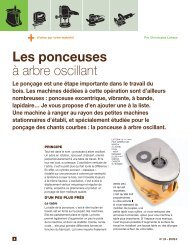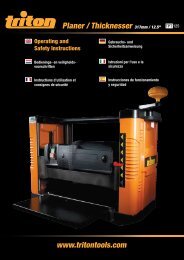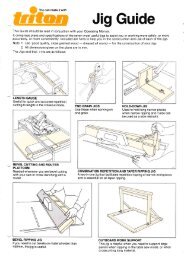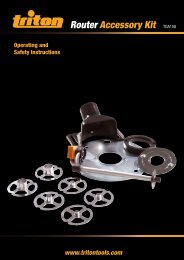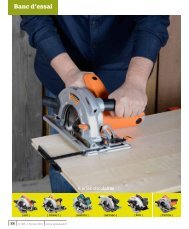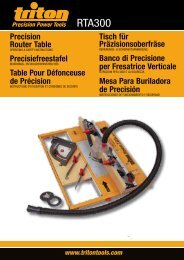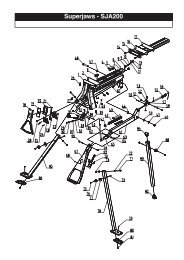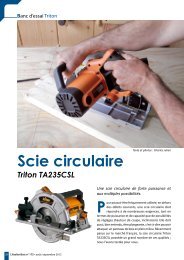Precision Power Saw 235mm / 9 ¼" TSA 001 - Triton Tools | Home
Precision Power Saw 235mm / 9 ¼" TSA 001 - Triton Tools | Home
Precision Power Saw 235mm / 9 ¼" TSA 001 - Triton Tools | Home
You also want an ePaper? Increase the reach of your titles
YUMPU automatically turns print PDFs into web optimized ePapers that Google loves.
RIPPING GUIDE<br />
• The Ripping Guide (5) can be used on the left or<br />
the right of the blade, as shown. Using the guide<br />
provides accurate cuts without the need to work<br />
'free-hand' following pencil lines.<br />
• Locate the guide into the mounting slots at the<br />
front of the baseplate and tighten the thumb<br />
screw to lock it at the desired cut width. For<br />
maximum width setting, the thumb screw<br />
can be relocated to the inner or outer clamp<br />
location.<br />
OPERATION<br />
• Rest the front of the baseplate on the workpiece<br />
with your pencil mark aligned with the correct<br />
sighting notch. Ensure the blade is not touching<br />
the workpiece.<br />
• Hold the saw firmly with both hands, as shown,<br />
and press the trigger. When the saw motor<br />
reaches full rotational speed, guide the saw<br />
smoothly along the cut line.<br />
• Maintain a consistent feed rate - too fast may<br />
put excessive strain on the motor, too slow<br />
may burnish your workpiece. Avoid any sudden<br />
movements of the saw.<br />
• When cutting veneered board or wood less than<br />
20mm thick, set the blade to protrude 5 - 10mm<br />
through the work. This will reduce splintering.<br />
When cutting thicker wood, set the blade to<br />
maximum depth to reduce kickback.<br />
• Wherever possible, avoid 'free-hand' cutting. It<br />
is much safer and more accurate to cut with the<br />
saw guided by a clamped-on batten, or by fitting<br />
the saw to a <strong>Triton</strong> Workcentre or Compact<br />
<strong>Saw</strong> Table. When cutting 'free-hand', mark out<br />
a straight cutting line, which can be used as a<br />
guide, avoiding the possibility of the saw drifting<br />
during operation.<br />
SIGHTING NOTCHES<br />
• Two sets of sighting notches near the front<br />
of the baseplate provide guidance when<br />
performing 'free-hand' cuts following a pencil<br />
line. Use the longer, narrower notches for 90°<br />
cuts and the shorter notches for 45° cuts. Sight<br />
along either edge of the notch, depending on<br />
which side of the line you wish to cut.<br />
• Use the second set of notches, closer to the<br />
saw blade, to confirm the alignment of your saw<br />
during the cut.<br />
• To avoid movement of the workpiece, use<br />
clamps wherever possible. Never perform any<br />
cuts on a workpiece held in the hand.<br />
• Large panels and long pieces must be well<br />
supported close to both sides of the cut to<br />
avoid pinching and kickback. Ensure the saw is<br />
positioned with the wider part of the baseplate<br />
resting on the larger piece, or on the piece with<br />
the best support.<br />
• Prevent kickback by ensuring that you move the<br />
saw in a straight line. Ensure that your blade is<br />
in good order and that the cut does not close in<br />
on the blade. If necessary, use a wedge or 3mm<br />
spacer in the cut to prevent it closing. Release<br />
the trigger if the saw gives any sign of stalling<br />
but do not remove the saw until the blade stops<br />
spinning.<br />
• Avoid cutting nails, screws etc. by inspecting<br />
your workpiece and removing any fasteners prior<br />
to cutting.<br />
• If unusual noise or odour occurs during operation<br />
stop the saw immediately and contact an<br />
authorised <strong>Triton</strong> <strong>Saw</strong> Repair Centre.<br />
Assembly / Operation<br />
7<br />
GB



